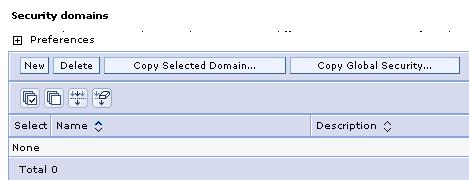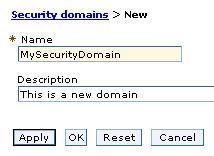Set multiple security domains
Overview
By default, all admin and user applications in WAS use the global security configuration. For example, a user registry defined in global security is used to authenticate users for every application in the cell.
We can create additional security domains to specify different security attributes for some or all of the user applications.
Enable global security before configuring multiple security domains. We can define different security (such as a different user registry) for user applications than for administrative applications. We can also define separate security configurations for user applications deployed to different servers and clusters.
Configure a new security domain
- Click...
-
Security | Security domains | New

Supply a unique name and description for the domain and click Apply.

To configure an existing multiple security domain, select one to edit. Once you click Apply the domain name and additional sections are displayed. One section enables you to define the security attributes for the domain, and another section enables you to select the scopes to which the domain applies.
- Under Assigned Scopes, select whether you want to assign the security domain to the entire cell or to select the specific servers, clusters, and service integration buses to be included in the security domain.
The Assigned Scopes section has two views. The default view is a cell topology. To assign the security domain to the entire cell, click the check box for the cell and then click Apply or OK.
The name of the security domain appears next to the cell name, which indicates that the domain is now assigned to the cell. We can expand the topology and assign the domain to one or more servers and clusters. When an item in the topology is already assigned to another security domain, the check box is disabled and the name of the assigned domain is displayed to the right of the scope name. To assign one of these scopes to the domain, first disassociate it with its current domain.
Select All assigned scopes to view a list of only those resources that are currently assigned to the security domain.
- Customize the security configuration by specifying security attributes for the new domain. Attributes that are not listed can not be customized at the domain level. Domains inherit attributes from the global security configuration.
There are twelve individually configurable security attribute sections. We can expand and collapse each section. In the collapsed state, the name and a summary value for the section are displayed. Additionally, the summary value text indicates whether the attribute is defined in global security and is reused by the domain (as indicated by gray text) or if it is customized for the domain (as indicated by black text prefixed by the word “Customized”).
Initially, each security attribute is set to use the global security settings. When an attribute is set to use global security, there is no domain-specific configuration for that attribute. Applications that use the domain use the global configuration for these security attributes.
Only configure the security attributes to change. To configure a security attribute for a domain, expand the security attribute section. The key properties of the global configuration display beneath the Use global security option. These properties are provided for convenience. To customize the configuration for the domain, select Customize for this domain. Set the property and then click OK or Apply.
In general, when you select Customize for this domain, you override all of the security configurations defined for that section in global security. Application logins, system logins, and J2C authentication data entries are some exceptions. When you define entries for a domain, applications in the domain are able to access the global entries in addition to the domain-specific entries.
For example, we might want to use a different user registry for applications that use the security domain but also want to use the global security configuration for all of the other security properties.
In this case, expand the User Realm section and select Customize for this domain. Select a user registry type, click Configure, and provide the appropriate configuration details on the subsequent panel. We can change security attributes such as the following:
- Application Security
- Settings for application security and Java2 security. Use the global security settings or customize the settings for a domain.
Select Enable application security to enable or disable security this choice for user applications. When this selection is disabled, all of the EJBs and Web apps in the security domain are no longer protected. Access is granted to these resources without user authentication. When you enable this selection, the J2EE security is enforced for all of the EJBs and Web apps in the security domain. The J2EE security is only enforced when Global Security is enabled in the global security configuration, (that is, we cannot enable application security without first enabling Global Security at the global level).
- Java 2 Security
- Select Java 2 security to enable or disable Java 2 security at the domain level. This choice enables or disables Java 2 security at the process (JVM) level so that all applications (both administrative and user) can enable or disable Java 2 security.
- User realm
-
This section enables you to configure the user registry for the security domain. We can separately configure any registry except the federated registry used at the domain level. The federated repository can only be configured at the global level but can be used at the domain level. Read about Multiple security domains for more information.
- Trust association
- When you configure the TAI at a domain level, the interceptors configured at the global level are copied to the domain level for convenience. We can modify the interceptor list at the domain level to fit the needs. Only configure those interceptors that are to be used at the domain level.
- SPNEGO Web Authentication
- The SPNEGO Web authentication, which enables you to configure SPNEGO for Web resource authentication, can be configured at the domain level.
In WAS V6.1, a TAI that uses the SPNEGO to securely negotiate and authenticate HTTP requests for secured resources was introduced. In WAS 7.0, this function is now deprecated. SPNEGO Web authentication has taken its place to provide dynamic reload of the SPNEGO filters and to enable fallback to the application login method.
- RMI/IIOP Security
-
The RMI/IIOP security attribute refers to the CSIv2 (Common Secure Interoperability version 2) protocol properties. When you configure these attributes at the domain level, the RMI/IIOP security configuration at the global level is copied for convenience.
We can change the attributes that need to be different at the domain level. The Transport layer settings for CSIv2 inbound communications should be the same for both the global and the domain levels. If they are different, the domain level attributes are applied to all of the application in the process.
- JAAS application logins
- Configuration settings for the JAAS application logins. Use the global security settings or customize the settings for a domain.
The JAAS application logins, the JAAS system logins, and the JAAS J2C authentication data aliases can all be configured at the domain level. By default, all of the applications in the system have access to the JAAS logins configured at the global level. The security runtime first checks for the JAAS logins at the domain level. If it does not find them, it then checks for them in the global security configuration. Configure any of these JAAS logins at a domain only when specify a login used exclusively by the applications in the security domain.
- JAAS system logins
- Configuration settings for the JAAS system logins. We can use the global security settings or customize the settings for a domain.
- JAAS J2C authentication
- Configuration settings for the JAAS J2C authentication data. Use the global security settings or customize the settings for a domain.
- Authentication Mechanism Attributes
-
Various cache settings that need to applied at the domain level.
Select Authentication cache settings to specify the authentication cache settings. The configuration specified on this panel is applied only to this domain.
Select LTPA Timeout to configure a different LTPA timeout value at the domain level. The default timeout value is 120 minutes, which is set at the global level. If the LTPA timeout is set at the domain level, any token that is created in the security domain when accessing user applications is created with this expiration time.
When Use realm-qualified user names is enabled, user names returned by methods such as getUserPrincipal( ) are qualified with the security realm (user registry) used by applications in the security domain.
- Authorization Provider
-
Configure an external third party JACC (Java Authorization Contract for Containers) provider at the domain level. TAM’s JACC provider can only be configured at the global level. Security domains can still use it if they do not override the authorization provider with another JACC provider or with the built-in native authorization.
- Custom properties
- Set custom properties at the domain level that are either new or different from those at the global level. By default, all of the custom properties at the global security configuration can be accessed by all of the applications in the cell. The security runtime code first checks for the custom property at the domain level. If it does not find it, it then attempts to obtain the custom property from the global security configuration.
- Once we have configured the security attributes and assigned the domain to one or more scopes, click Apply or OK.
- Restart all servers and clusters for the changes to take effect.
Multiple security domains
Create new multiple security domains
Delete multiple security domains
Copy multiple security domains
Set inbound trusted realms for multiple security domains
Set security domains
External realm name
Trust all realms
Security domains collection
Authentication cache settings
Related tasks
Set security domains using scripting
Set multiple security domains using scripting
Remove security domains using scripting
Mapping resources to security domains using scripting
Task overview: Securing resources
Related
Administrative roles